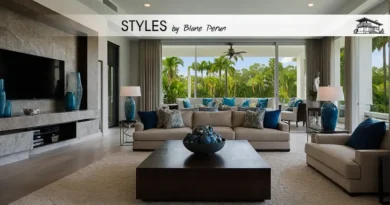Minimalist Style
Unveiling the Elegance of Minimalist Interior Design
In today’s fast-paced world, the concept of “less is more” has never been more relevant, especially in the realm of home decor. Minimalist Interior Design, a trend that emphasizes simplicity, functionality, and clarity, has gained significant traction. This design philosophy, deeply rooted in the Japanese concept of Zen, seeks to create spaces that resonate with tranquility and harmony. By focusing on essential elements and stripping away the superfluous, minimalist interior design offers a retreat from the chaos of everyday life, providing a serene environment where one can relax and rejuvenate.

The Essence of Minimalist Spaces
The Role of Color in Minimalist Design
Color plays a pivotal role in minimalist interior design, acting as a canvas that shapes the mood and atmosphere of a space. Neutral palettes, featuring shades like white, beige, and gray, are hallmark elements. These understated tones help in achieving a sense of calm and spaciousness, making the room appear larger and more open. The strategic use of color in minimalist spaces isn’t just about aesthetics; it’s a deliberate choice that influences how we perceive and interact with our environment. Incorporating subtle textures and materials can add depth and warmth to these neutral schemes, ensuring the space feels inviting rather than sterile.
Minimalism and Functional Furniture
Furniture selection is crucial in minimalist interior design, where each piece must serve a purpose and contribute to the overall aesthetic. Opting for sleek, contemporary furniture with clean lines not only complements the minimalist ethos but also enhances the functionality of the space. This approach to furniture is about finding a balance between form and function, where items are chosen not just for their practicality but also for their ability to blend seamlessly into the minimalist canvas. The emphasis on quality over quantity means that each piece is thoughtfully selected, ensuring that the space remains uncluttered and cohesive.
The Art of Decluttering and Organization
Embracing Negative Space
Negative space, or the area that surrounds objects in a room, is a fundamental component of minimalist interior design. This concept isn’t about emptiness for the sake of emptiness; it’s about the strategic use of space to highlight the items that do occupy a room, allowing them to take center stage. By embracing negative space, minimalist design encourages us to reconsider the purpose and value of each item in our homes, leading to more intentional living spaces that reflect our true needs and aesthetic preferences.
Innovative Storage Solutions
In minimalist design, storage solutions are not just practical necessities; they’re integral to maintaining the clean, uncluttered look that defines the style. Hidden storage compartments, built-in units, and multi-functional furniture are key elements that help keep clutter out of sight, preserving the serene and orderly vibe of minimalist spaces. These innovative storage options ensure that everything has its place, contributing to a sense of calm and order that is essential to minimalist living.
Lighting and Textures in Minimalist Decor
Natural Light and Minimalist Interiors
In minimalist interior design, natural light is more than just a way to brighten a room; it’s a vital component that shapes the space’s mood and atmosphere. Large windows, sheer curtains, and strategically placed mirrors are used to enhance the flow of natural light, creating airy and expansive interiors. This emphasis on natural light not only highlights the room’s features but also promotes a connection with the outside world, blurring the boundaries between indoor and outdoor living.
The Role of Texture in Adding Depth
While minimalist design might seem stark to some, the use of textures plays a crucial role in adding warmth and depth to these spaces. Textures, whether through fabrics, woods, or metals, introduce variety and tactile interest, preventing the space from feeling flat or monotonous. Incorporating different textures through rugs, throw pillows, or wall finishes can add layers to a minimalist interior, making it more inviting and comfortable while still adhering to the minimalist ethos.
Minimalist Interior Design offers a refreshing take on home decor, emphasizing the beauty of simplicity and the value of thoughtful design. By focusing on essentials and eliminating the unnecessary, minimalist spaces promote clarity, tranquility, and a sense of harmony that resonates deeply in today’s complex world.

FAQs on Minimalist Interior Design
What defines Minimalist Interior Design?
Minimalist Interior Design is characterized by simplicity, functionality, and a monochromatic color palette. It focuses on the essentials to create a serene and clutter-free space. Furniture and decor are chosen for their utility and aesthetic appeal, with an emphasis on quality and craftsmanship.
How can I make my minimalist space feel warm and inviting?
To add warmth to a minimalist space, incorporate textures through soft furnishings like rugs, throw pillows, and blankets. Use warm, neutral colors for walls and furniture, and ensure there’s plenty of natural light. Indoor plants can also add a touch of warmth and life to minimalist decor.
What kind of lighting works best in minimalist interiors?
Natural light is ideal for minimalist spaces, enhancing the sense of openness and connection with the outdoors. For artificial lighting, opt for simple, sleek fixtures that blend with the decor. Use layered lighting, including ambient, task, and accent lights, to add depth and interest.
Can minimalist design be colorful?
Yes, minimalist design can include color, but it’s typically used sparingly as an accent to add depth and interest to the space. Stick to a limited color palette with one or two accent colors to maintain the minimalist aesthetic while incorporating personality and warmth.
How do I start transitioning to a minimalist interior design?
Begin by decluttering and removing unnecessary items. Focus on quality over quantity, choosing furniture and decor that are both functional and aesthetically pleasing. Stick to a neutral color scheme with clean lines and use textures and natural light to add warmth and depth to your space.





